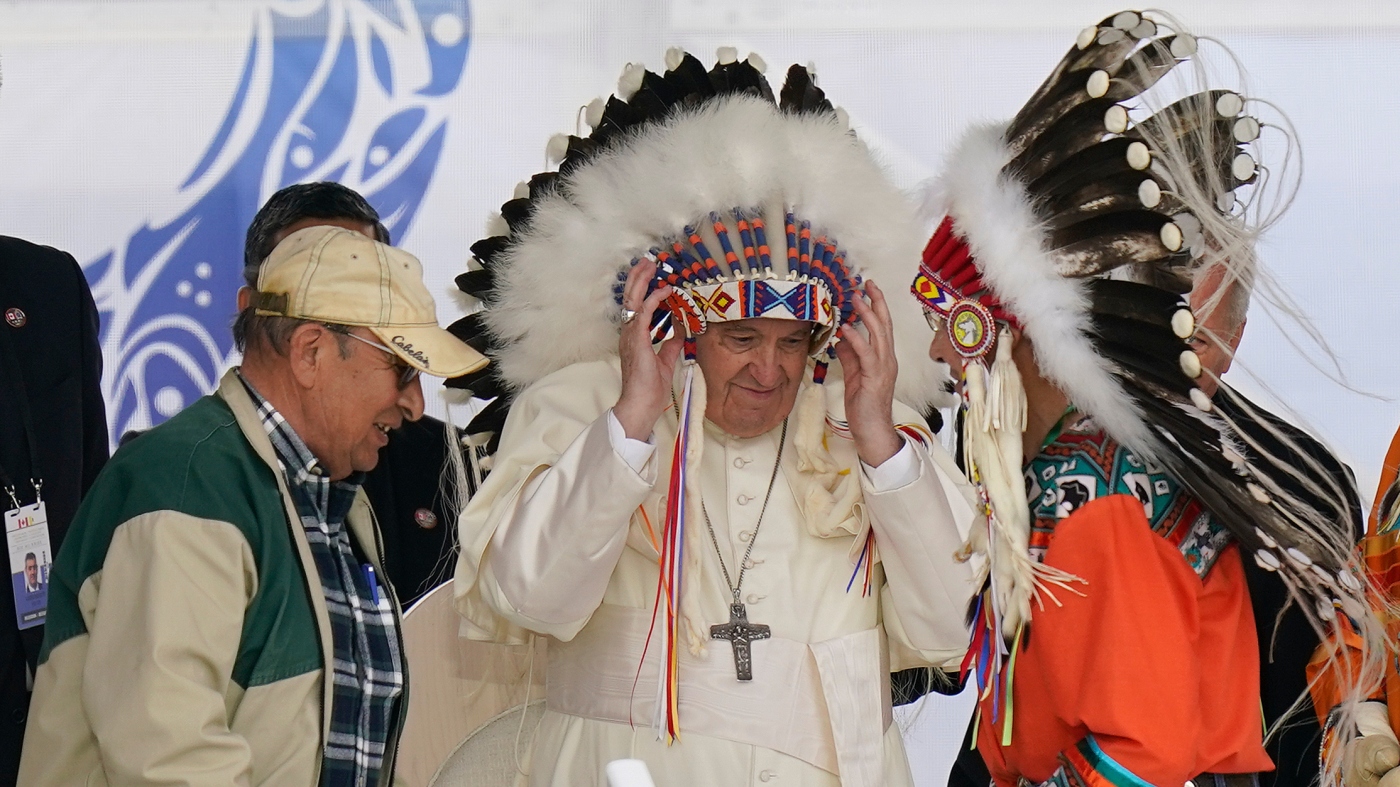Pope Francis dons a headdress during a visit to Indigenous people at the former Ermineskin Residential School in Maswachis, Alberta, July 25, 2022. On Saturday, the Vatican returned 62 artifacts from Canada to Indigenous people.
Eric Gay/AP
hide signature
switch signature
Eric Gay/AP
VATICAN. The Vatican returned 62 artifacts to Indigenous people from Canada on Saturday. This is historic restitution and is part of the Catholic Church's reckoning for its role in helping to suppress indigenous cultures in the Americas.
Pope Leo XIV handed over the artifacts, including an iconic Inuit kayak, and supporting documentation to a delegation of the Canadian Conference of Catholic Bishops, which is expected to return them to individual First Nations communities. A joint statement between the Vatican and the Canadian Church called the works a “gift” and “a concrete sign of dialogue, respect and fraternity.”
These objects were part of the ethnographic collection of the Vatican Museum, known as the Anima Mundi Museum. The collection has become a source of controversy at the Vatican amid a broader museum debate over the restitution of cultural property taken from indigenous peoples during colonial periods.
Most of the items in the Vatican collection were sent to Rome by Catholic missionaries for a 1925 exhibition in the Vatican Gardens. The Vatican insists the items were “gifts” to Pope Pius XI, who wanted to celebrate the global reach of the church, its missionaries and the lives of the indigenous people they evangelized.
But historians, indigenous groups and experts have long questioned whether these items could truly have been offered for free, given the power imbalance that existed at the Catholic missions at the time. During those years, Catholic religious orders helped implement the Canadian government's forced assimilation policy to eradicate Indigenous traditions, which the Truth and Reconciliation Commission of Canada called “cultural genocide.”
Part of these policies included the confiscation of items used in Indigenous spiritual and traditional rituals, such as the 1885 potlatch ban, which prohibited a single Indigenous ceremony. Confiscated items ended up in museums in Canada, the USA and Europe, as well as in private collections.
Negotiations are accelerating on the return of goods
Talks about returning Vatican items accelerated after Pope Francis met in 2022 with Indigenous leaders who came to the Vatican to seek his apology for the church's role in running Canada's disastrous residential schools. During the visit, they were shown some items from the collection, including an Inuit kayak, wampum belts, war clubs and masks, and asked to return them.
Francis later said he favored the return of objects and other items from the Vatican collection on a case-by-case basis, saying: “In a case where you can return things where a gesture needs to be made, it is better to do so.”
The Vatican said Saturday that the items were returned during the Holy Year, exactly 100 years after the 1925 exhibition in which they were first displayed in Rome as the main event of the anniversary.
“This is an act of ecclesial exchange through which the Successor of Peter gives to the Church in Canada these artifacts that testify to the history of the encounter between faith and indigenous cultures,” the Vatican and the Canadian Church said in a joint statement.
He added that the Canadian Catholic hierarchy has committed to ensuring that the artifacts are “properly protected, respected and preserved.” Officials have previously said Canadian bishops will receive the artifacts with the express understanding that the ultimate custodians will be the Indigenous communities themselves.
The items are expected to first go to the Canadian Museum of History in Gatineau, Quebec. There, experts and indigenous groups will try to determine the items' origins, down to a specific community, and what should be done with them, officials previously said.
The process of paying for abuse
Canadian Ambassador to the Holy See Joyce Napier said the return was a key priority for the Canadian government and the embassy had been working on it for years with the Holy See, the Canadian Church and Indigenous communities.
“This is a historic event that Indigenous people have asked for,” she told The Associated Press. “Today’s announcement is an important step towards reconciliation.”
As part of its broader reckoning with the Catholic Church's colonial past, the Vatican in 2023 formally rejected the “Doctrine of Discovery,” theories backed by 15th-century “papal bulls” that legitimized colonial-era seizures of indigenous lands that form the basis of some property laws today.
The statement marked a historic recognition of the Vatican's complicity in abuses committed by European powers during the colonial era, although it did not address indigenous demands that the Vatican formally rescind the papal bulls themselves.
On Saturday, the Vatican in a statement referred to the abandonment of the Doctrine of Discovery in 2023, saying Leo's return of the artifacts completes the “journey” begun by Francis.












